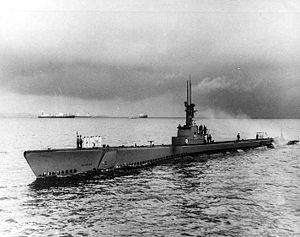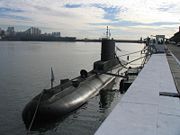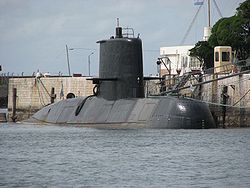
Argentine Submarine Force
Encyclopedia
The Argentine Submarine Force (Spanish
: Comando de la Fuerza de Submarinos, COFS) is the submarine service
branch of the Argentine Navy
. Argentine submarines have traditionally been named after the provinces of the Republic
and they are home based at Mar del Plata
naval base. COFS members have the same rank insignia and titles as the rest of the Navy. As of 2010, the elite group Agrupación de Buzos Tácticos
is under direct command of the submarine force and two TR-1700
and one Type 209
submarines are in service. Two small surface vessels, ARA Punta Mogotes (P-65) and ARA Luisito (Q-51), are also part of the COFS and use in the training role.
to began training courses at the Naval Submarine School. Lieutenants Francis Lajous, Osvaldo Repeto, Eduardo Ceballos and Vicente Ferrer served in the US Navy during the First World War.
in order to build the service's first three ships. The units arrived to Buenos Aires
on April 7, 1933 and transferred to Mar del Plata on September 3 which became the Anniversary Day for the newly created Submarine Force. The Tarantinos, as they were known, served between 1933 and 1960 when the last one (Santa Fe) waas retired after taking over a thousand dives.
 In April 1960 the US Navy agree to transfer two units on loan under the Military Assistance Program. They departed from San Francisco, California on September 23 of the same year and arrived in Mar del Plata on November 30. These ships will participated on numerous exercises during their career including UNITAS, CAIMAN, SAYONARA and CAIO DULIO. They went back to the United States for a mid life repair and were finally retired in 1971.
In April 1960 the US Navy agree to transfer two units on loan under the Military Assistance Program. They departed from San Francisco, California on September 23 of the same year and arrived in Mar del Plata on November 30. These ships will participated on numerous exercises during their career including UNITAS, CAIMAN, SAYONARA and CAIO DULIO. They went back to the United States for a mid life repair and were finally retired in 1971.
submarines were an interim measure until new submarines being built in Europe became available. Santiago del Estero was retired by September 1981 but Santa Fe would take part on the 1982 Falklands War
. She land Buzos Tacticos on the initial amphibious assault
and weeks later after a successful resupply mission was spotted on the surface, attacked and disabled off South Georgia. She was scuttled by the British after the war ended.
 In 1969 a contract was signed in West Germany
In 1969 a contract was signed in West Germany
for two Type 209 submarines. The ships were of the 56 metres/1100 ton sub-type and were built in parts by Howaldtswerke
at Kiel and delivered to Tandanor
shipyard in Buenos Aires where the final assembly was completed in 1973. They were commissioned in 1974 but only San Luis was in service during the 1982 Falklands War
. She reported two encounters with Royal Navy ships but without scoring hits due to problems with her torpedo system. San Luis was struck from the Navy in 1997 after an incomplete overhaul whilst Salta was still in service as of 2010.
 As part of a major fleet renovation plan which includes the MEKO
As part of a major fleet renovation plan which includes the MEKO
frigates classes, a contract was signed in 1977 with West Germany's Thyssen Nordseewerke for six TR-1700 class
submarines with the last four of them to be built in Argentina. The Argentine Navy sponsored the development of the CAREM
nuclear reactor to be installed on these submarines but for political reasons the whole program was dismantled and only the two German units were delivered. These ships are the largest submarines built in Germany since World War II and are among the fastest diesel-electric submarines in the world.
Spanish language
Spanish , also known as Castilian , is a Romance language in the Ibero-Romance group that evolved from several languages and dialects in central-northern Iberia around the 9th century and gradually spread with the expansion of the Kingdom of Castile into central and southern Iberia during the...
: Comando de la Fuerza de Submarinos, COFS) is the submarine service
Submarine
A submarine is a watercraft capable of independent operation below the surface of the water. It differs from a submersible, which has more limited underwater capability...
branch of the Argentine Navy
Argentine Navy
The Navy of the Argentine Republic or Armada of the Argentine Republic is the navy of Argentina. It is one of the three branches of the Armed Forces of the Argentine Republic, together with the Army and the Air Force....
. Argentine submarines have traditionally been named after the provinces of the Republic
Provinces of Argentina
Argentina is subdivided into twenty-three provinces and one autonomous city...
and they are home based at Mar del Plata
Mar del Plata
Mar del Plata is an Argentine city located on the coast of the Atlantic Ocean, south of Buenos Aires. Mar del Plata is the second largest city of Buenos Aires Province. The name "Mar del Plata" had apparently the sense of "sea of the Río de la Plata region" or "adjoining sea to the Río de la Plata"...
naval base. COFS members have the same rank insignia and titles as the rest of the Navy. As of 2010, the elite group Agrupación de Buzos Tácticos
Tactical Divers Group
The Tactical Divers Group is the premier special operations force of the Argentine Navy. The Buzos Tácticos are based at Base Naval Mar del Plata on the Atlantic coast of Argentina. Its men are highly qualified combat divers, EOD/demolition technicians, and parachutists.The APBT was the first...
is under direct command of the submarine force and two TR-1700
TR-1700 class submarine
The TR-1700 is a class of diesel-electric patrol submarines built by Thyssen Nordseewerke for the Argentine Navy in the 1980s. These ships are the largest submarines built in Germany since World War II and are among the fastest diesel-electric submarines in the world.- Development :The original...
and one Type 209
Type 209 submarine
The Type 209 is a class of diesel-electric attack submarine developed exclusively for export in the late 1960s by Howaldtswerke-Deutsche Werft of Germany...
submarines are in service. Two small surface vessels, ARA Punta Mogotes (P-65) and ARA Luisito (Q-51), are also part of the COFS and use in the training role.
History
In 1917 the Navy sent students to the United StatesUnited States
The United States of America is a federal constitutional republic comprising fifty states and a federal district...
to began training courses at the Naval Submarine School. Lieutenants Francis Lajous, Osvaldo Repeto, Eduardo Ceballos and Vicente Ferrer served in the US Navy during the First World War.
First generation
In 1927 the Navy signed a contract with the Italian shipyard Franco Tosi of TarantoTaranto
Taranto is a coastal city in Apulia, Southern Italy. It is the capital of the Province of Taranto and is an important commercial port as well as the main Italian naval base....
in order to build the service's first three ships. The units arrived to Buenos Aires
Buenos Aires
Buenos Aires is the capital and largest city of Argentina, and the second-largest metropolitan area in South America, after São Paulo. It is located on the western shore of the estuary of the Río de la Plata, on the southeastern coast of the South American continent...
on April 7, 1933 and transferred to Mar del Plata on September 3 which became the Anniversary Day for the newly created Submarine Force. The Tarantinos, as they were known, served between 1933 and 1960 when the last one (Santa Fe) waas retired after taking over a thousand dives.
- ARA Santa Fe (S-1)
- ARA Santiago del Estero (S-2)
- ARA Salta (S-3)
Second generation

- ARA Santa Fe (S-11), ex
- ARA Santiago del Estero (S-12), ex
Third generation
In 1971 the US Navy transferred further units in order to replace the previous generation. Two GUPPY-typeGreater Underwater Propulsion Power Program
The Greater Underwater Propulsion Power Program was initiated by the United States Navy after World War II to improve the submerged speed, maneuverability, and endurance of its submarines....
submarines were an interim measure until new submarines being built in Europe became available. Santiago del Estero was retired by September 1981 but Santa Fe would take part on the 1982 Falklands War
Falklands War
The Falklands War , also called the Falklands Conflict or Falklands Crisis, was fought in 1982 between Argentina and the United Kingdom over the disputed Falkland Islands and South Georgia and the South Sandwich Islands...
. She land Buzos Tacticos on the initial amphibious assault
1982 invasion of the Falkland Islands
On 2 April 1982, Argentine forces mounted amphibious landings of the Falkland Islands . The invasion involved an initial defence force organised by the Falkland Islands' Governor Sir Rex Hunt giving command to Major Mike Norman of the Royal Marines, the landing of Lieutenant-Commander Guillermo...
and weeks later after a successful resupply mission was spotted on the surface, attacked and disabled off South Georgia. She was scuttled by the British after the war ended.
- ARA Santa Fe (S-21), ex
- ARA Santiago del Estero (S-22), ex
Fourth generation

West Germany
West Germany is the common English, but not official, name for the Federal Republic of Germany or FRG in the period between its creation in May 1949 to German reunification on 3 October 1990....
for two Type 209 submarines. The ships were of the 56 metres/1100 ton sub-type and were built in parts by Howaldtswerke
Howaldtswerke
Howaldtswerke-Deutsche Werft is a German shipbuilding company, headquartered in Kiel. In 2009 it was the largest shipyard in Germany and has more than 2,400 employees. It has been part of ThyssenKrupp Marine Systems owned by ThyssenKrupp, since 2005...
at Kiel and delivered to Tandanor
Tandanor
Tandanor is an Argentine worker-owned shipyard, and the nation's largest. Tandanor is involved in shipbuilding and ship repair and has facilities in Buenos Aires' port....
shipyard in Buenos Aires where the final assembly was completed in 1973. They were commissioned in 1974 but only San Luis was in service during the 1982 Falklands War
Falklands War
The Falklands War , also called the Falklands Conflict or Falklands Crisis, was fought in 1982 between Argentina and the United Kingdom over the disputed Falkland Islands and South Georgia and the South Sandwich Islands...
. She reported two encounters with Royal Navy ships but without scoring hits due to problems with her torpedo system. San Luis was struck from the Navy in 1997 after an incomplete overhaul whilst Salta was still in service as of 2010.
- ARA Salta (S-31)
- ARA San Luis (S-32)
Fifth generation

MEKO
The MEKO family of warships was developed by the German company Blohm + Voss.MEKO is a registered trademark. The portmanteau stands for "Mehrzweck-Kombination" . It is a concept in modern naval shipbuilding based on modularity of armament, electronics and other equipment, aiming at ease of...
frigates classes, a contract was signed in 1977 with West Germany's Thyssen Nordseewerke for six TR-1700 class
TR-1700 class submarine
The TR-1700 is a class of diesel-electric patrol submarines built by Thyssen Nordseewerke for the Argentine Navy in the 1980s. These ships are the largest submarines built in Germany since World War II and are among the fastest diesel-electric submarines in the world.- Development :The original...
submarines with the last four of them to be built in Argentina. The Argentine Navy sponsored the development of the CAREM
CAREM
CAREM is an Argentine nuclear reactor designed by CNEA .- History :The reactor was first developed as a request of the Argentine Navy to power the TR-1700 submarine of German design. In 1984 it was presented publicly for the first time during an IAEA conference in Peru...
nuclear reactor to be installed on these submarines but for political reasons the whole program was dismantled and only the two German units were delivered. These ships are the largest submarines built in Germany since World War II and are among the fastest diesel-electric submarines in the world.
- ARA Santa Cruz (S-41)
- ARA San Juan (S-42)
External links
History of Submarine force at Official site- Official Museum Fuerza de Submarinos de la Armada Argentina at deyseg.com.ar Argentine submarines at elsnorkel.com

